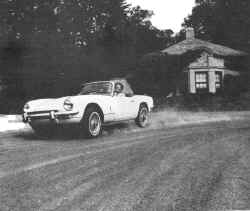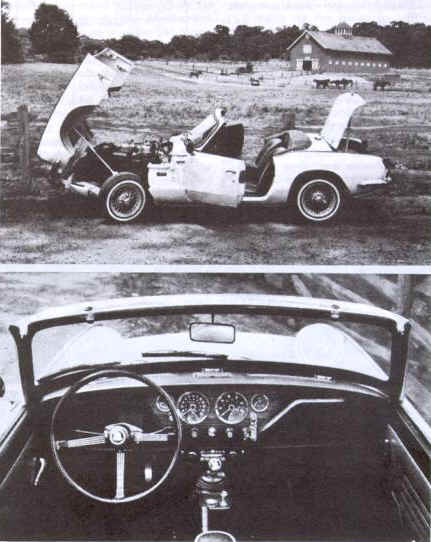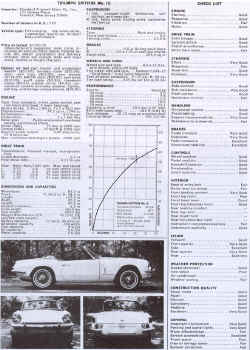
All
this was a Good Deal back in 1962 when the Triumph Spitfire was
introduced, and it is still that today-with improve- ments. Now that the
Spitfire Mk. III is here, you can have your low-cost fun and some
of the civilizing influences as well. No longer, for example, is it
necessary to stop and drag the convertible top out of the trunk every
time it rains. Triumph has given us one that folds down behind the seats
and can be pulled up into place without even getting out of the car. We
suffered much in the old days from the cold drafts and dripping water. A
top that is actually air- and water-tight really gets our attention, and
the Spitfire has one. Neither torrential rains nor gale-force winds
encroach into the cockpit. You stay warm and dry.
Sometimes
you stay much warmer than you would really like. Engine heat, in warm
weather (ambient air-temperature anything above 70'F.) becomes
uncomfortable, and the level of discomfort rises sharply.
There
are vents that should do a lot to help this situation. Air is
picked up from an intake grillework in the cowl, and a little door is
opened to let this air flow into the car. In practice, it never seems to
flow in very fast and with the outlets placed as they are, the air wafts
across one's kneecaps, never nearing the feet.
On
the other hand, the defrosting sys- tem is enough to make a long-time
sporty- car fancier weep for joy. Hark back to the days when a really
hearty sigh of relief (or a sigh of anything) would mist over
every window in any sport car made and you will appreciate what this
means. We chose to drive top-down even in the most inclement weather in
those days and called it "sporting spirit." It was really done
be- cause that was the only way one could be sure of seeing anything.
When the Tri- umph's windows get all misty, just flick the blower switch
and the windshield clears instantly.
Before continuing, a couple of further comments about the top. First, it must be said that the thing is ringed with transpar- ent plastic, and visibility is superb to be- hold. Second, the shape and position of the clamps holding top to windshield could easily become imbedded in the foreheads of the occupants should an impact make them nod forward with sufficient energy. The Spitfire is, happily, fitted with the belt- and-shoulder-strap safety harness, and we would recommend that this be secured over one's torso at all times.
There's
a bit of the Walter Mitty in all of us. James Thurber's original would
climb into the family sedan, and in his imagining it became a Spitfire
and he was someone like the legendary Cobber Caine of the RAF. Cloth
helmet, goggles and scarf streaming in the slipstream. Making England
safe from the Hun. Locked in battle. Machine guns rattling, the ieek of
burning cordite. Curse you, Red Baron!
Thurber has since gone to his reward but thousands of his Walter Mittys are still with us. And the contemporary Mitty buys a contemporary Spitfire, which is now an automobile. When our Walter Mitty climbs
into
the cockpit, he becomes Dan Gurney, about to set forth at Le Mans or
Spa. String- back gloves. Driving shoes. Coveralls with
"Goodyear" over the breast pocket. At a touch, the
finely-tuned engine springs into life. Clutch in; the gearchange lever
snicks forward into first. The Spitfire leaps away as a ghostly flag
sweeps down. Of such stuff are dreams made, and it can be yours for only
$2279 plus tax and license.


